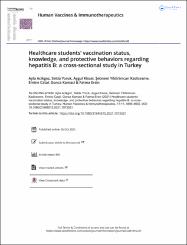| dc.contributor.author | Açıkgöz, Ayla | |
| dc.contributor.author | Yörük, Selda | |
| dc.contributor.author | Kissal, Aygül | |
| dc.contributor.author | Kadıceşme, Şebnem Yıldırımcan | |
| dc.contributor.author | Çatal, Emine | |
| dc.contributor.author | Kamacı, Gonca | |
| dc.contributor.author | Ersin, Fatma | |
| dc.date.accessioned | 2022-08-16T07:54:30Z | |
| dc.date.available | 2022-08-16T07:54:30Z | |
| dc.date.issued | 2021 | en_US |
| dc.identifier.issn | 2164-5515 - 2164-554X | |
| dc.identifier.uri | https://doi.org/10.1080/21645515.2021.1973321 | |
| dc.identifier.uri | https://hdl.handle.net/20.500.12462/12452 | |
| dc.description | Yörük, Selda (Balikesir Author) | en_US |
| dc.description.abstract | Aim We aimed to determine the vaccination status, knowledge, and protective behaviors of healthcare students related to hepatitis B and to examine the related factors. Method This cross-sectional study was conducted in seven universities from seven geographical regions of Turkey. The study group included 5451 healthcare students. Data were collected with a questionnaire including items on sociodemographic characteristics, vaccination status, knowledge and protective behaviors related to hepatitis B. Data were analyzed with Pearson's chi-square and logistic regression analyses. Results 86.0% of the students had hepatitis B vaccine while 7.6% did not. Vaccination was higher in nursing and midwifery students (aOR = 1.87, CI 95%: 1.26-2.77; aOR = 3.87, CI 95%: 2.14-7.02, respectively). Vaccination was 1.28 times higher in females (CI 95% 1.03-1.60). The >= 23 age group had 1.79 times higher vaccination rate than those in the <= 19 (CI 95%: 1.26-2.53). Vaccination was higher in students whose family's economic status is middle and high (aOR = 1.53, CI 95%: 1.07-2.19; aOR = 1.47, CI 95%: 1.03-2.19, respectively). Vaccination was higher in those living in towns and cities during childhood (aOR = 1.36, CI 95%: 1.06-1.74; aOR = 1.79, CI 95%: 1.34-2.38, respectively). Females had more knowledge of hepatitis B and protective behaviors. Both knowledge and protective behavior scores of vaccinated participants were significantly higher (p < .05). Conclusion We found that the vaccination rate in healthcare students was high, but lower than the country's targets. The students were sensitive about the protective behaviors from hepatitis B infection and had sufficient knowledge of HBV contamination. | en_US |
| dc.language.iso | eng | en_US |
| dc.publisher | Taylor & Francis Inc | en_US |
| dc.relation.isversionof | 10.1080/21645515.2021.1973321 | en_US |
| dc.rights | info:eu-repo/semantics/openAccess | en_US |
| dc.subject | Hepatitis B | en_US |
| dc.subject | Healthcare Students | en_US |
| dc.subject | Hepatitis B Infection Prevention | en_US |
| dc.subject | Knowledge | en_US |
| dc.subject | Practice | en_US |
| dc.subject | Vaccination | en_US |
| dc.title | Healthcare students' vaccination status, knowledge, and protective behaviors regarding hepatitis B: a cross-sectional study in Turkey | en_US |
| dc.type | article | en_US |
| dc.relation.journal | Human Vaccines and Immunotherapeutics | en_US |
| dc.contributor.department | Sağlık Bilimleri Fakültesi | en_US |
| dc.contributor.authorID | 0000-0003-4570-5031 | en_US |
| dc.contributor.authorID | 0000-0003-3840-1996 | en_US |
| dc.contributor.authorID | 0000-0002-8000-7880 | en_US |
| dc.identifier.volume | 17 | en_US |
| dc.identifier.issue | 11 | en_US |
| dc.identifier.startpage | 4595 | en_US |
| dc.identifier.endpage | 4602 | en_US |
| dc.relation.publicationcategory | Makale - Uluslararası Hakemli Dergi - Kurum Öğretim Elemanı | en_US |


















